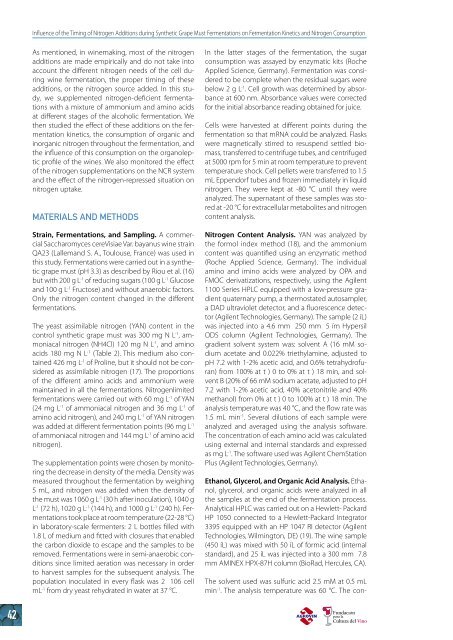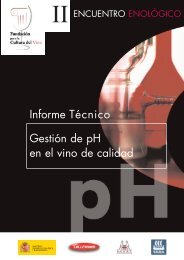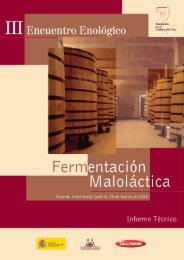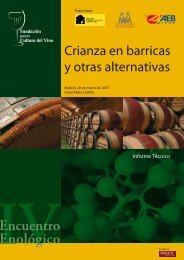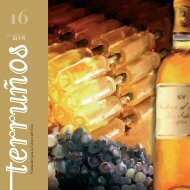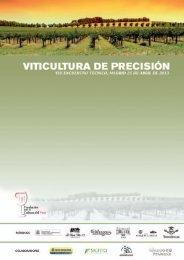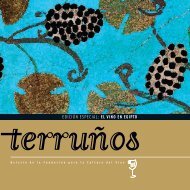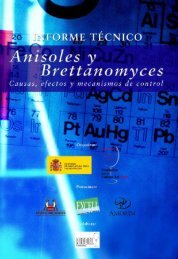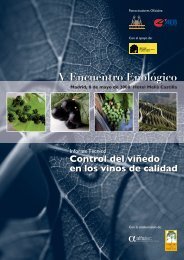Compuestos azufrados volátiles en vinos - Fundación para la ...
Compuestos azufrados volátiles en vinos - Fundación para la ...
Compuestos azufrados volátiles en vinos - Fundación para la ...
You also want an ePaper? Increase the reach of your titles
YUMPU automatically turns print PDFs into web optimized ePapers that Google loves.
Influ<strong>en</strong>ce of the Timing of Nitrog<strong>en</strong> Additions during Synthetic Grape Must Ferm<strong>en</strong>tations on Ferm<strong>en</strong>tation Kinetics and Nitrog<strong>en</strong> ConsumptionAs m<strong>en</strong>tioned, in winemaking, most of the nitrog<strong>en</strong>additions are made empirically and do not take intoaccount the differ<strong>en</strong>t nitrog<strong>en</strong> needs of the cell duringwine ferm<strong>en</strong>tation, the proper timing of theseadditions, or the nitrog<strong>en</strong> source added. In this study,we supplem<strong>en</strong>ted nitrog<strong>en</strong>-defici<strong>en</strong>t ferm<strong>en</strong>tationswith a mixture of ammonium and amino acidsat differ<strong>en</strong>t stages of the alcoholic ferm<strong>en</strong>tation. Weth<strong>en</strong> studied the effect of these additions on the ferm<strong>en</strong>tationkinetics, the consumption of organic andinorganic nitrog<strong>en</strong> throughout the ferm<strong>en</strong>tation, andthe influ<strong>en</strong>ce of this consumption on the organolepticprofile of the wines. We also monitored the effectof the nitrog<strong>en</strong> supplem<strong>en</strong>tations on the NCR systemand the effect of the nitrog<strong>en</strong>-repressed situation onnitrog<strong>en</strong> uptake.MATERIALS AND METHODSStrain, Ferm<strong>en</strong>tations, and Sampling. A commercialSaccharomyces cereVisiae Var. bayanus wine strainQA23 (Lallemand S. A., Toulouse, France) was used inthis study. Ferm<strong>en</strong>tations were carried out in a syntheticgrape must (pH 3.3) as described by Riou et al. (16)but with 200 g L -1 of reducing sugars (100 g L -1 Glucoseand 100 g L -1 Fructose) and without anaerobic factors.Only the nitrog<strong>en</strong> cont<strong>en</strong>t changed in the differ<strong>en</strong>tferm<strong>en</strong>tations.The yeast assimi<strong>la</strong>ble nitrog<strong>en</strong> (YAN) cont<strong>en</strong>t in thecontrol synthetic grape must was 300 mg N L -1 , ammoniacalnitrog<strong>en</strong> (NH4Cl) 120 mg N L -1 , and aminoacids 180 mg N L -1 (Table 2). This medium also contained426 mg L -1 of Proline, but it should not be consideredas assimi<strong>la</strong>ble nitrog<strong>en</strong> (17). The proportionsof the differ<strong>en</strong>t amino acids and ammonium weremaintained in all the ferm<strong>en</strong>tations. Nitrog<strong>en</strong>limitedferm<strong>en</strong>tations were carried out with 60 mg L -1 of YAN(24 mg L -1 of ammoniacal nitrog<strong>en</strong> and 36 mg L -1 ofamino acid nitrog<strong>en</strong>), and 240 mg L -1 of YAN nitrog<strong>en</strong>was added at differ<strong>en</strong>t ferm<strong>en</strong>tation points (96 mg L -1of ammoniacal nitrog<strong>en</strong> and 144 mg L -1 of amino acidnitrog<strong>en</strong>).The supplem<strong>en</strong>tation points were chos<strong>en</strong> by monitoringthe decrease in d<strong>en</strong>sity of the media. D<strong>en</strong>sity wasmeasured throughout the ferm<strong>en</strong>tation by weighing5 mL, and nitrog<strong>en</strong> was added wh<strong>en</strong> the d<strong>en</strong>sity ofthe must was 1060 g L -1 (30 h after inocu<strong>la</strong>tion), 1040 gL -1 (72 h), 1020 g L -1 (144 h), and 1000 g L -1 (240 h). Ferm<strong>en</strong>tationstook p<strong>la</strong>ce at room temperature (22-28 °C)in <strong>la</strong>boratory-scale ferm<strong>en</strong>ters: 2 L bottles filled with1.8 L of medium and fitted with closures that <strong>en</strong>abledthe carbon dioxide to escape and the samples to beremoved. Ferm<strong>en</strong>tations were in semi-anaerobic conditionssince limited aeration was necessary in orderto harvest samples for the subsequ<strong>en</strong>t analysis. Thepopu<strong>la</strong>tion inocu<strong>la</strong>ted in every f<strong>la</strong>sk was 2 106 cellmL -1 from dry yeast rehydrated in water at 37 °C.In the <strong>la</strong>tter stages of the ferm<strong>en</strong>tation, the sugarconsumption was assayed by <strong>en</strong>zymatic kits (RocheApplied Sci<strong>en</strong>ce, Germany). Ferm<strong>en</strong>tation was consideredto be complete wh<strong>en</strong> the residual sugars werebelow 2 g L -1 . Cell growth was determined by absorbanceat 600 nm. Absorbance values were correctedfor the initial absorbance reading obtained for juice.Cells were harvested at differ<strong>en</strong>t points during theferm<strong>en</strong>tation so that mRNA could be analyzed. F<strong>la</strong>skswere magnetically stirred to resusp<strong>en</strong>d settled biomass,transferred to c<strong>en</strong>trifuge tubes, and c<strong>en</strong>trifugedat 5000 rpm for 5 min at room temperature to prev<strong>en</strong>ttemperature shock. Cell pellets were transferred to 1.5mL Epp<strong>en</strong>dorf tubes and froz<strong>en</strong> immediately in liquidnitrog<strong>en</strong>. They were kept at -80 °C until they wereanalyzed. The supernatant of these samples was storedat -20 °C for extracellu<strong>la</strong>r metabolites and nitrog<strong>en</strong>cont<strong>en</strong>t analysis.Nitrog<strong>en</strong> Cont<strong>en</strong>t Analysis. YAN was analyzed bythe formol index method (18), and the ammoniumcont<strong>en</strong>t was quantified using an <strong>en</strong>zymatic method(Roche Applied Sci<strong>en</strong>ce, Germany). The individua<strong>la</strong>mino and imino acids were analyzed by OPA andFMOC derivatizations, respectively, using the Agil<strong>en</strong>t1100 Series HPLC equipped with a low-pressure gradi<strong>en</strong>tquaternary pump, a thermostated autosampler,a DAD ultraviolet detector, and a fluoresc<strong>en</strong>ce detector(Agil<strong>en</strong>t Technologies, Germany). The sample (2 íL)was injected into a 4.6 mm 250 mm 5 ím HypersilODS column (Agil<strong>en</strong>t Technologies, Germany). Thegradi<strong>en</strong>t solv<strong>en</strong>t system was: solv<strong>en</strong>t A (16 mM sodiumacetate and 0.022% triethy<strong>la</strong>mine, adjusted topH 7.2 with 1-2% acetic acid, and 0.6% tetrahydrofuran)from 100% at t ) 0 to 0% at t ) 18 min, and solv<strong>en</strong>tB (20% of 66 mM sodium acetate, adjusted to pH7.2 with 1-2% acetic acid, 40% acetonitrile and 40%methanol) from 0% at t ) 0 to 100% at t ) 18 min. Theanalysis temperature was 40 °C, and the flow rate was1.5 mL min -1 . Several dilutions of each sample wereanalyzed and averaged using the analysis software.The conc<strong>en</strong>tration of each amino acid was calcu<strong>la</strong>tedusing external and internal standards and expressedas mg L -1 . The software used was Agil<strong>en</strong>t ChemStationPlus (Agil<strong>en</strong>t Technologies, Germany).Ethanol, Glycerol, and Organic Acid Analysis. Ethanol,glycerol, and organic acids were analyzed in allthe samples at the <strong>en</strong>d of the ferm<strong>en</strong>tation process.Analytical HPLC was carried out on a Hewlett- PackardHP 1050 connected to a Hewlett-Packard Integrator3395 equipped with an HP 1047 RI detector (Agil<strong>en</strong>tTechnologies, Wilmington, DE) (19). The wine sample(450 íL) was mixed with 50 íL of formic acid (internalstandard), and 25 íL was injected into a 300 mm 7.8mm AMINEX HPX-87H column (BioRad, Hercules, CA).The solv<strong>en</strong>t used was sulfuric acid 2.5 mM at 0.5 mLmin -1 . The analysis temperature was 60 °C. The con-42


